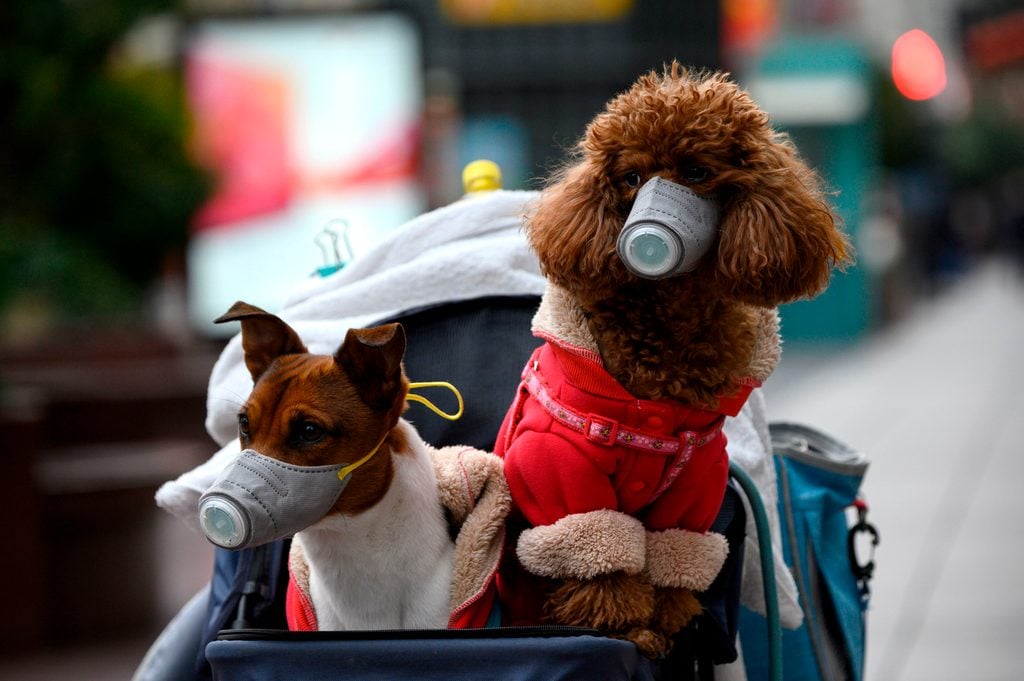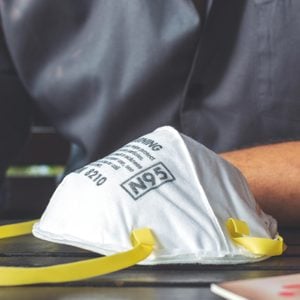Should Your Dog Be Wearing a Pet Mask?
Updated: Nov. 24, 2022

Is it a smart precaution—or an unnecessary measure that will only agitate your pup? Here’s what the experts currently believe.
If you have a dog, the following questions have crossed your mind at some point over the last few weeks: Can dogs catch or spread the novel coronavirus, and should I take specific measures to protect mine? The concern is twofold, of course. We love our fur babies and want to keep them safe, but we also want to protect ourselves and our human loved ones. So, if we’re all wearing face masks, it only makes sense that our dogs should be wearing them, too…or does it? We asked veterinarians to weigh in.
Can dogs catch the novel coronavirus?
The answer seems to be no, according to the latest available research. The Centers for Disease Control and Prevention (CDC) announced on April 22 that two pet cats in the United States had become infected with the virus, as well as several tigers and lions at the Bronx Zoo. However, “currently we have no information that suggests that pets might be a source of infection for people with the coronavirus that causes COVID-19…[But] until more is known about this virus, if you are ill with COVID-19 you should restrict contact with pets and other animals, just as you would restrict your contact with other people,” the American Veterinary Medical Association (AVMA) reports. The CDC also updated its guidelines in late April, advising pet parents not to allow their dogs to interact with anyone outside of the household and to make sure they socially distance from humans and other dogs when on walks.
Natalie Marks, DVM, a veterinarian for the VCA Blum Animal Hospital and the founder of Fear Free Pets, adds that other research indicates that there isn’t an immediate risk to dogs. “The journal Science last week published a study [on its website] that stated that dogs are not vulnerable to this virus,” says Dr. Marks. The study also found that chickens, pigs, and ducks are unlikely to catch it, as well.
But haven’t some dogs tested positive for COVID-19?
At the end of March, it was reported that two dogs in Hong Kong—living in the homes of humans with COVID-19—tested positive for the novel coronavirus. This sparked understandable fear in owners around the globe and pushed experts to figure out how this was possible.
“The test that was used is very good at detecting any parts of the virus, but what it doesn’t tell you is whether those parts of the virus detected were just bits and pieces of it or an intact, functional virus,” says Keri Bayley, DVM, a veterinarian at Indian Trail Animal Hospital in Spokane, Washington. “A dog rummages around your home, sniffs, and licks objects all the time, and what particles could end up in his nose or throat? The answer: many.” In other words, it’s possible that virus particles (or fragments of the particles) showed up on a very sensitive coronavirus test, but it doesn’t mean that it actually infected the dogs.
“The first dog had no clinical signs at all, and the second dog was a 17-year-old small breed dog in heart failure who already had respiratory signs,” says Dr. Marks. “Idexx Reference Labs has since tested thousands of dogs in the United States and has had no positives. At this time, again, leading experts agree that it is highly unlikely that these two dogs were infectious—aka clinically sick from the virus and able to transmit to others—but were probably more exposed simply from being in the environment.”
The first case of canine infection in the United States
On April 28, a dog in North Carolina tested positive for the novel coronavirus—the first confirmed case of canine infection in the United States. While the pug didn’t display any severe symptoms, the family says that he was coughing and didn’t eat breakfast one morning. The family also tested positive for COVID-19, and they all had mild cases.
Still, veterinarians say there’s no reason to panic. “We still don’t have evidence of the virus circulating in the bloodstream. This pug also happened to be a cuddly member of the family, slept with his owners, and frequently licked plates from the dishwasher. He easily could have acquired virus particles just from these means,” explains Dr. Bayley, adding that the Department of Agriculture will follow up with more testing. “There was a low amount of the virus or virus particles detected in [his] mucous membranes.”
Dr. Bayley adds that the president of the AVMA has suggested that it is highly possible that this dog acquired the virus particles from his environment, just like the dogs in Hong Kong. It’s also important to note that this same family had another dog, a cat, and a lizard, and all of the other animals tested negative.
And there is another mitigating factor to consider. “Pugs tend to exhibit regular respiratory symptoms daily just from the type of breed they are, with short muzzles and oversized tongues and palates,” says Dr. Bayley. “Though the pug may have stopped eating or sneezed or acted off, it could have been unrelated, or as discussed earlier, [the dog] may have mounted some sort of an immune response but didn’t amplify the virus and spread it. It ended in the dog host.”
In general, these are the signs your “healthy” dog is showing illness symptoms.
Can dogs transmit COVID-19 to humans or other dogs?
Since a test is able to pick up particles of the novel coronavirus on an exposed canine, the question then becomes whether said canines can transmit those particles elsewhere. Vets say this is highly unlikely. “We would be naive to assume that humans are so distinct that we don’t share much of the basic physiology we see across the mammalian world. We do. However, how a virus sustains itself is by mutating and adapting and finding the best host for its purpose,” Dr. Bayley explains. “Right now, it appears that maybe a dog—based on only two dogs in Hong Kong—living in a household with its positive COVID-19 human companion could demonstrate positive viral particles in its mucous membranes. And maybe it could mount an immune response to those particles and demonstrate antibodies that were made.”
In other words, a virus may be able to enter a different species, but it will likely “get confused” and either fizzle out or cause a different response than anticipated. “The virus may wreak havoc in its optimum human host, but in a dog, nothing may happen clinically—it’s a dead end for the virus,” Dr. Bayley says. “The dog can’t spread it back to humans because it didn’t start something in the first place.”
Should my dog wear a pet mask to protect against COVID-19?
There are, indeed, face masks created specifically for pups that can be adjusted according to muzzle size. Marketing claims state that pet masks can help prevent dust and/or pollen inhalation, minimize exposure to secondhand smoke, avoid respiratory infections, prevent biting, chewing, or ingesting off-limits materials, and minimize barking. But though they exist—and you might see a trend emerging where dogs are wearing masks in public—that doesn’t mean they should be worn. In fact, each of the veterinarians we spoke to say that having your dog wear a face mask isn’t necessary and is likely a futile effort, anyway.
“I do not recommend the use of pet masks,” says Dr. Bayley. “There is not enough circulation nor room in these masks for proper ventilation and panting to occur, which dogs need to be able to do. They also can’t access water. This is especially not good with flat-faced dogs, as it could be very dangerous to restrict airflow to these dogs.”
Plus, if we consulted the millions of people around the world now wearing face masks, we’d likely hear complaints about how cumbersome, hot, and poorly ventilated they are. A dog would tell you the same thing. “Imagine what it must feel like to the dog who already is confused why they can’t see their human’s facial expressions if they’re also wearing a mask,” Dr. Bayley adds. “This makes it difficult for them to know how to respond, and it also suffocates the number one sensory organ they use to navigate this world.”
The bottom line
Based on all the information experts have collected to date, there is a small to nonexistent risk of your dog contracting or spreading the novel coronavirus. The highest risk of infection to people remains in contact with another human who is either clinically ill or an asymptomatic carrier.
Out of an abundance of caution, however, experts do recommend the following:
- Wash your hands thoroughly before and after petting your pooch.
- Do not let your dog interact with other animals or humans outside your home.
- Keep your pup on a leash when walking outdoors and maintain at least a six-foot distance between other pets and humans. “If you live in a large city or heavily populated area, opt to take your dog down less-heavily-trafficked blocks, or try adjusting walks to less busy times of day and night,” the AKC advises.
- Steer clear of spaces where groups might gather, including public parks, hiking trails, and even dog parks.
- If you’ve tested positive for COVID-19, ask another member in your home to look after your dog until you’ve been cleared by your doctor. If that’s not possible, avoid close interactions, including snuggles, kisses, and sharing sleeping and lounging spaces. When tending to your dog, wear gloves and a mask out of caution.
- Continue practicing excellent personal hygiene and keep your home clean by wiping down surfaces with products that kill coronavirus, sweeping, dusting, and vacuuming.
For more on this developing situation, including how to stay safe and sane, see our comprehensive Coronavirus Guide.

